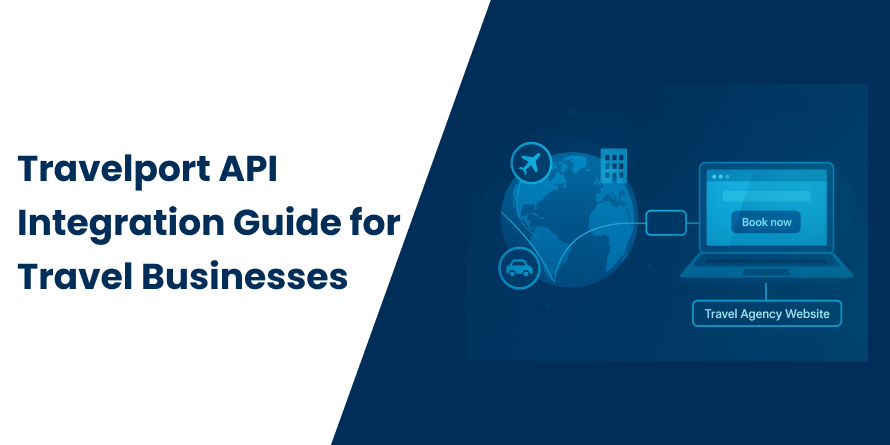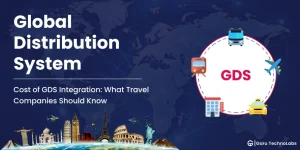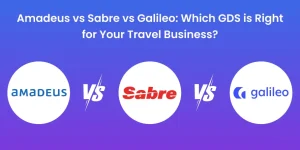Want more bookings on your travel platform? Of course you do, every travel business owner does. But to win in today’s market, it’s not just about offering flights or hotels. You need to deliver a smooth booking experience where customers can search, compare, and reserve flights, hotels, cars, and more. It has become the new standard for user experience. And that’s exactly where Travelport API integration comes in.
If you landed on this blog, you’re probably looking to learn more about Travelport API, whether it’s to compare API options, gather data, or explore integration for your business. Well, you’re in the right place.
Travelport is one of the world’s leading GDS providers, giving businesses access to a massive inventory of airlines, hotels, car rentals, and cruise lines.
By integrating the Travelport API into your booking platform, you unlock powerful features that simplify operations and expand your offerings. For business owners, whether you run an OTA or a new travel startup, understanding how this integration works is key to identifying growth opportunities, reducing manual work, and staying competitive in a fast-moving market.
In this guide, we’ll cover everything you need:
- What is the Travelport API?
- Types of Travelport API,
- Step-by-step integration process,
- Pricing considerations,
- Common challenges (plus how to overcome them).
By the end, you’ll have a clear roadmap to plan your own Travelport API integration with confidence.
What is the Travelport API?
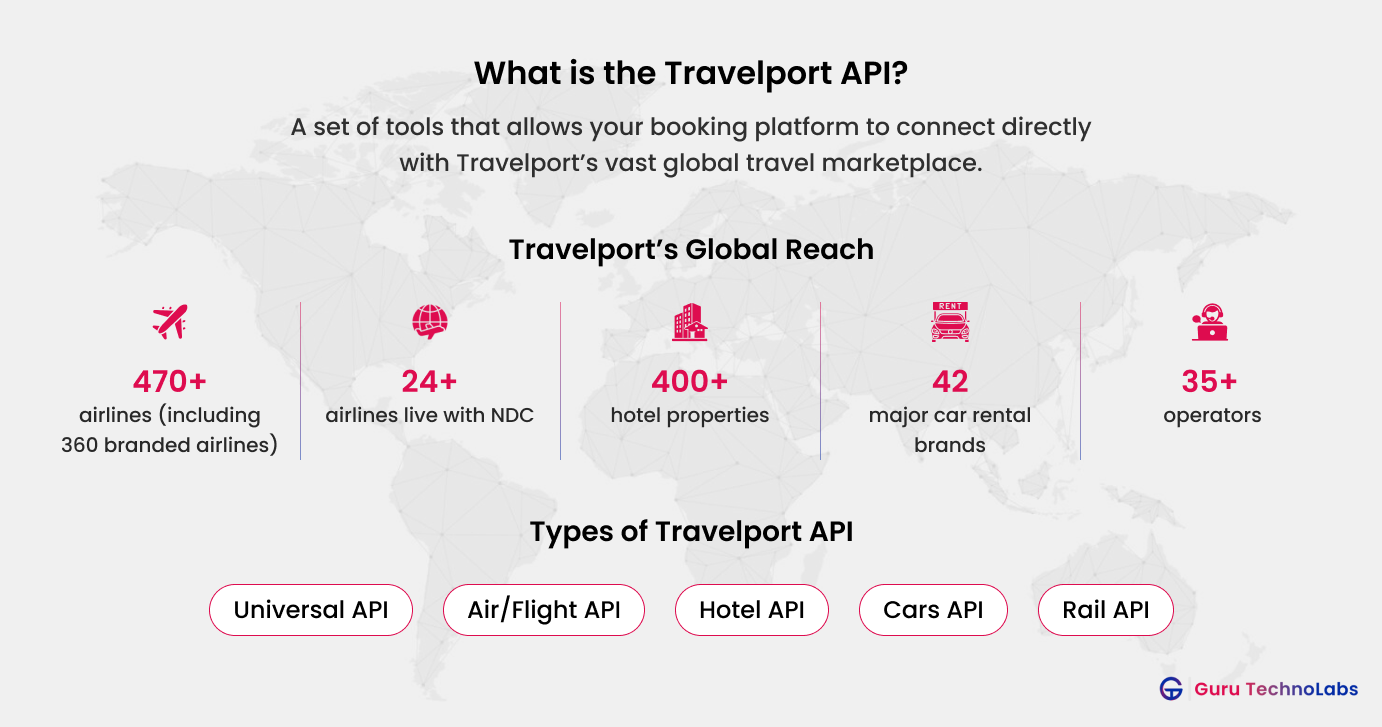
Travelport API is a set of tools that allows your booking platform to connect directly with Travelport’s vast global travel marketplace. Instead of manually managing multiple suppliers or relying on outdated systems, the API gives you real-time access to flights, hotels, cars, and more, all from a single integration.
With these APIs, travel businesses can handle everything from searching and comparing options to booking and ticketing in real time. By integrating this API, you’re essentially plugging into a global travel ecosystem.
Travelport has also modernized its platform with JSON APIs that support IATA’s New Distribution Capability (NDC) content alongside traditional GDS fares, helping agencies deliver richer booking experiences and better pricing options.
Travelport’s Global Reach:
- 470+ airlines (including 360 branded airlines)
- 24+ airlines live with NDC
- 3 million+ hotel and property listings
- 42 major car rental brands
- 35+ rail operators
Why It Matters for Business Owners
For travel agencies, OTAs, and startups, integrating the Travelport API isn’t just a tech upgrade, it’s a way to compete with larger players by offering customers more choice, faster booking, and a seamless digital experience. Whether you focus on the US, Canada, or Europe, Travelport’s reach ensures you’re connected to global content that drives growth.
Types of Travelport API
Travelport offers a flexible API suite designed to fit different types of travel businesses. Depending on your goals, you can either connect through the Universal API for all-in-one access or choose individual APIs to target specific services like flights, hotels, or cars.
Travelport Universal API
The Universal API is Travelport’s flagship product. With one integration, you can access flights, hotels, cars, and rail content from multiple sources, including both traditional GDS inventory and IATA NDC content(with the help of travelport ndc api). This makes it ideal for agencies and OTAs that want a comprehensive solution without juggling multiple connections.
It’s a time-saver, cost-effective, and scalable option for businesses looking to provide travelers with a seamless shopping and booking experience across all travel categories.
Individual APIs
For businesses that want more control or prefer to add services gradually, Travelport also provides service-specific APIs. These allow you to integrate only what you need, with the option to expand later.
- Air/Flight API: Travelport Flight API allows you to search flights by date, class, or route; view live fares, book, and issue e-tickets. Supports multicity and calendar view searches.
- Hotel API: The Travelport Hotel API gives access to millions of properties with rates, photos, and descriptions; book or cancel in real time.
- Cars API: Connect to 42 car rental brands; check availability, compare prices, and book instantly.
- Rail API: Mainly for Europe; search train schedules, availability, and book tickets.
- Aggregated Search API: Combines flights, hotels, and cars into a single search for faster results.
- SeatMap API: View seat layouts and availability so travelers can choose seats before checkout.
All Travelport APIs return real-time pricing and availability, ensuring your platform stays up to date and competitive.
Benefits of Integrating Travelport API into Your Platform
Integrating the Travelport API isn’t just about adding content, it’s about transforming how your travel business operates and grows. From expanding your inventory to streamlining processes, here’s how it can give you a competitive edge:
1. Massive Global Inventory: Access to hundreds of airlines and thousands of hotels, with many more, all in one integration.
2. Real-Time Availability & Pricing: Show live fares, schedules, and availability to reduce errors and build customer trust.
3. Multi-GDS Connectivity: Connect with multiple GDSs via one API for broader content and flexibility. Explore more on the Benefits of GDS.
4. Unified Development: “Code once, connect everywhere” — simplify integration and speed up launch.
5. Advanced Features: Offer ancillaries, dynamic packaging, and personalized NDC fares to boost sales.
6. Wide Device & Channel Support: Deliver the best booking experience across web, mobile, and apps.
7. Business Growth & Scalability: Automate workflows, expand reach, and increase bookings with less effort.
Now as we discussed the benefits of travelport api, let’s discuss the integration process of travelport api into your platform.
Step-by-step Process of Travelport API Integration
Integrating the Travelport API is a structured program, not a single coding task. Below is a practical, step-by-step view that business owners can use to plan, budget, and manage the project.
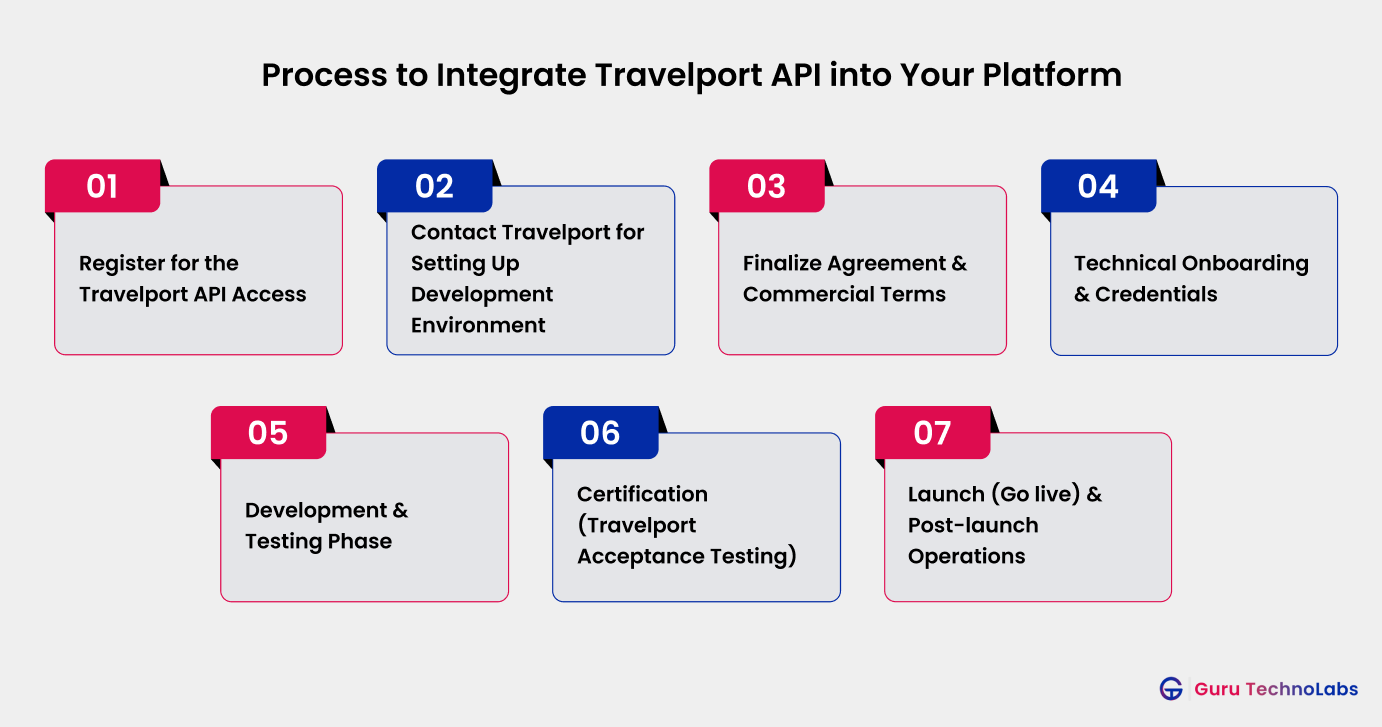
1. Register for the Travelport API Access
The first step is to register on Travelport’s Developer Network. This gives you access to API documentation, sample code, and sandbox credentials that your team can use for testing.
It’s a safe environment to explore how the API works and validate the features you’ll need before moving into any commercial agreements.
2. Contact Travelport for Setting Up Development Environment
Once you’ve outlined your requirements, the next step is to work with Travelport (or a certified partner) to set up your development environment. This includes defining your commercial terms, selecting the APIs you’ll use, and preparing the technical framework your team will build on.
Getting this right from the start makes the integration process smoother and ensures you’re set up with the right tools and support.
3. Finalize Agreement & Commercial Terms
At this stage, you’ll review Travelport’s proposal and negotiate the key details, such as fees, booking volumes, and service commitments. Since pricing is customized, it’s important to clarify all costs upfront, including any setup, access, or per-transaction charges.
Once everything is agreed, the contract is signed, giving you a clear roadmap of commercial terms and expectations. This step ensures there are no surprises later and that both sides are aligned before moving into technical integration.
4. Technical Onboarding & Credentials
Once the agreement is in place, Travelport will provide the access details your team needs to start building. This typically includes sandbox credentials, API keys, and technical documentation. You’ll also receive support contacts to guide you through setup.
This stage ensures your developers or integration partner such as Guru TechnoLabs have everything required to connect your platform with Travelport in a secure and structured way, setting the foundation for smooth testing and development.
5. Development & Testing Phase
In this stage, your platform is connected with Travelport’s APIs and tested thoroughly in a safe sandbox environment. Developers or integration partners build out the booking flow, covering searches, pricing, reservations, and ticketing. While also adding extras like seat selection or baggage if required.
As a business owner, your role is to review and approve the booking journey, payment flow, and overall user experience to make sure it matches your expectations. By the end of this phase, all functions are tested against real-world scenarios so your system is stable, accurate, and ready for certification.
6. Certification (Travelport Acceptance Testing)
Before going live, Travelport runs a formal certification process to make sure your system works correctly and meets their standards. This involves testing sample bookings, ticketing, cancellations, and refunds to confirm everything functions smoothly.
If any issues come up, they’re resolved in collaboration with Travelport’s test team or your integration partner. Once certification is approved, you’ll receive production credentials that allow you to handle live bookings.
Think of this stage as a final quality checkpoint that ensures your platform is reliable, accurate, and ready for real customers.
7. Launch (Go live) & Post-launch Operations
Once certification is complete, your platform switches to production and starts handling real bookings. Many businesses prefer a phased rollout, such as limiting it to certain markets or agents first to ensure a smooth start.
At this stage, it’s important to train your teams, put monitoring tools in place, and have a clear support channel with Travelport or your integration partner.
After launch, keep a close eye on booking success rates, errors, and customer feedback. Regular monitoring and quick issue resolution protect both revenue and customer trust, while ongoing performance tuning helps your platform scale confidently over time.
Process is on-works now as a business owner, you must have knowledge of the travelport api pricing, final steps to get started.
Travelport API Pricing and Integration Cost
Integrating the Travelport API typically involves an upfront investment, with most travel businesses spending on average around $4,000–$5,000 for setup and initial integration. This cost varies based on the APIs you choose, your booking volumes, and whether you work directly with Travelport or through a certified partner.
Travelport’s GDS (Global Distribution System) is designed to give travel businesses a unified platform to access travel inventory. It is a critical tool for modern OTAs and travel agencies. For a deeper breakdown of all factors, you can also check our guide on the cost of GDS integration.
Key Travelport API Pricing Components:
- One-time Setup Fees
- Developer Access Fees
- Transaction Fees
- Support or Premium Services
- Security Deposits
- Third-Party Partner or Consultant Fees
Each of these costs is customized based on your business needs, so there’s no fixed pricing. Understanding these components helps you plan your budget and maximize ROI from the Travelport integration.
Challenges Business Owners Face (and How to Overcome Them)
While integrating Travelport API brings global travel content and automation to your platform, business owners often face several challenges. Understanding these obstacles and addressing them early can make travel API integration smoother and more effective.
1. Complexity of Travelport API & Limited Technical Expertise
Travelport API offers extensive features, but its scope can feel overwhelming, especially for small travel businesses or startups without in-house developers.
The solution: Partnering with the best api integration provider or experienced developers familiar with GDS integration. Clear project planning and step-by-step testing also help reduce errors.
2. Hidden Costs and Pricing Confusion
Travelport pricing is customized, and additional fees for setup, transactions, premium support, or security deposits can make budgeting tricky.
The solution: Request a detailed cost breakdown and review contract terms carefully. Working with an integration partner can help you anticipate hidden costs and optimize your investment, ensuring your travel API integration delivers value without surprises.
3. Support & Maintenance
After going live, your platform needs continuous support to manage updates, errors, or scaling issues. Without proper monitoring, downtime or errors can affect bookings and customer trust.
The solution: Establish clear support channels with Travelport and assign internal team members to track performance.
4. Ensuring Scalability and Reliability
High booking volumes, multiple APIs, and real-time searches can strain your system, leading to slow responses or downtime.
The solution: To ensure smooth operations, implement robust monitoring, load balancing, and error-handling mechanisms. Plan for growth from the beginning, so your system can handle peak traffic without downtime or slow responses.
Why Work With a Travelport API Integration Partner?
Integrating the Travelport API isn’t just a technical project, it’s a strategic move that can shape the future of your travel business. From setup and pricing negotiations to certification, testing, and ongoing support, the process has many layers that can feel overwhelming for business owners who want to focus on growth, not technical roadblocks.
That’s why many agencies, OTAs, and startups choose to work with a Travelport API integration partner, whether you need travel api or Flight API Integration. Instead of navigating the complexity alone, you get the benefit of:
- Expert guidance from day one
- Faster time to market
- Tailored solutions for your business model
- Ongoing support and scalability
In the end, working with a trusted partner allows you to focus on what matters most, building your brand, serving your customers, and growing your bookings. While the technical complexity of travel API integration is handled by specialists.
If you’re ready to expand, reach out to us. At Guru TechnoLabs, we specialize in Travelport API integration and other travel technology solutions, helping OTAs, travel agencies, and startups launch faster, reduce costs, and scale confidently in a competitive market.
Frequently Asked Questions
Travelport API is a set of tools that connects your travel platform with Travelport’s global inventory of flights, hotels, cars, and more in real time.
Travelport API pricing is customized, but on average businesses spend $4,000–$5,000 for setup and integration, plus annual developer fees and per-transaction costs. The final price depends on your booking volume, API selection, and support requirements.
Travelport Universal API gives a single connection to multiple travel services, flights, hotels, cars, and rail, saving time and reducing complexity.
It is often simply called Travelport UAPI or UAPI in documentation and industry usage.
Galileo is one of Travelport’s GDS platforms. Travelport is the parent company, which also owns Worldspan and Apollo.
NDC (New Distribution Capability) in Travelport enables airlines to sell personalized offers, bundles, and rich content beyond traditional GDS fares.
